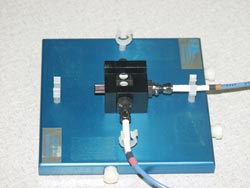
Detecting microbes, in space and on Earth
Cleanliness isn’t just next to godliness in space habitats,
it is vital to survival. Microbes that aren’t quickly detected and stopped
from infestation could prove catastrophic onboard the international space station,
the space shuttle and manned lunar and Mars missions. Exponentially growing microorganisms
would quickly contaminate these closed environments.
“What is needed for space missions is a
lightweight, portable benchtop system requiring low power and maintenance to efficiently
detect microorganisms,” said NASA electronics engineer Maximilian C. Scardelletti.
Such a system also would be valuable in hospitals, laboratories and clinics, as
well as for bioterrorism field diagnostics, he said.
Unfortunately, conventional detection
techniques often involve culturing bacteria, which can take days. These approaches
also require elaborate procedures or expensive and bulky equipment, or both.
Now Scardelletti and research assistant
Vanessa A. Varaljay-Spence have developed a benchtop technique to detect microbes
in fluids. The method involves nanofiltration, spectrometry and near-infrared fluorescent
dyes conjugated to antibodies. It exhibits much higher sensitivity than other approaches,
and it is less expensive and faster. It also offers the potential of detecting multiple
microbes quickly and simultaneously from a single sample.
The greater sensitivity, according
to Varaljay-Spence, is a consequence of the spectrum the technique uses. “The
NIR region greatly improves sensitivity of detection because membranes and biomolecules
have low autofluorescence in this region, thus reducing background noise,”
she said.
While noting that the hardware and
accompanying software are important, Scardelletti said that the crucial enabling
concept behind this approach is the nanofiltration of the antibody/NIR dyes and
the antigens, or microbes. “The large size difference between the antibody
and antigen is key to the nanofiltration process,” he said.

A method that might make detecting microbes in space easier involves using a spectrometer
for detection of NIR dyes. Detection in this region improves sensitivity.
Antibodies come in at a molecular weight
of perhaps 150 kDa, while microbes carry weights of thousands of kilodaltons. Thus,
a free antibody conjugated with a dye would weigh well under 200 kDa, while one
bound to an anti-gen would be part of a complex that weighs more than 1000 kDa.
The NASA team used a 300K nanofilter
from Pall Lifesciences Corp. of Ann Arbor, Mich., that allows anything less than
300 kDa in weight through while stopping anything that weighs more. When centrifuged,
any antibodies in solution that didn’t bind to the microbe in question would
filter through. Because of that, they wouldn’t be excited by the laser when
it scanned the top of the membrane, eliminating false-positives.
In a proof-of-concept experiment, the
NASA group used a laser from LaserPath Technologies of Oviedo, Fla., operating at
780 nm and tunable by 5 nm up or down. They fed the beam into a cuvette sample holder
using a fiber optic cable with a micromirror mounted on the opposite side to bounce
the light back through the sample.
They captured the resulting emission
with another cable at right angles to the first two and sent the emission into a
spectrometer from Ocean Optics Inc. of Dunedin, Fla. Opposite this cable, they
placed another micromirror, increasing the amount of light being measured. Using
software to control the spectrometer, the researchers quickly found the emission
peak and its intensity.
They used an NIR dye from Li-Cor Biosciences
of Lincoln, Neb., that Rockland Immunochemicals Inc. of Gilbertsville, Pa., conjugated
with anti-IgM, the complement to the antibody IgM. They didn’t use microbes
because they didn’t have the testing facilities, but Scardelletti noted that
the binding of dye-conjugated antibodies to microbes has been demonstrated in other
systems.
The researchers conducted experiments
using anti-IgM and IgM, with the lasers tuned to 778 nm with a peak power of 879
pW. The dyes’ 804-nm emission was detected by the spectrometer. They performed
40 experiments and found that, on average, 80 percent of the time the emission intensity
count exceeded 100, the threshold for a positive result. There was some variability
in the percentage above the threshold, probably caused by fluctuations in the nanofiltration
and differences in antibody concentrations.
To determine the technique’s
rate of false-positives, they conducted 20 more experiments using the nonspecific
antigens beta galactosidase and thyroglobulin. No false-positives were detected.
Although promising, the technique and
its implementation could be improved in a number of ways. For example, the NIR laser
was compact and lightweight but not miniaturized. Because less than a nanowatt of
power is required, a NIR diode laser that is cheaper, smaller and lower in power
could be used. Combining that with a microfluidic cavity would reduce the overall
size and cost of the system. And the accuracy of the positive results could be improved
by going to a silicon-based microfabricated nanopore filter, Scardelletti said.
Unlike the polyethylene membranes used in the proof-of-concept experiments, the
size and distribution of pores in microfabricated filters is consistent throughout.
The ability to tune the laser through
a wider range, along with fluorophores with narrower emission spectra than the dye
used, would enable detection of microbes to be multiplexed. However, Varaljay-Spence
cautioned that there is no market for narrowband NIR dyes and that it is unclear
when — or even if — they will be developed.
Scardelletti noted that one goal of
the project is to miniaturize the benchtop system to a lab-on-a-chip device that
can be used in laboratory clinics for diagnostic testing of blood samples for infectious
diseases. “What we hope to achieve in the end is the ability to detect thousands
of different microbes in a single fluid sample,” he said.
Contact: Maximilian C. Scardelletti,
NASA Glenn Research Center at Lewis Field, Brook Park, Ohio; e-mail: [email protected].
Published: September 2006